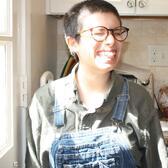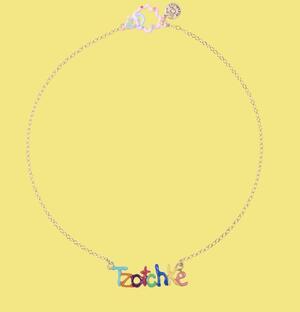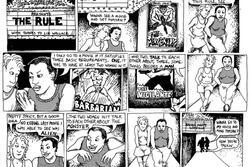The Judaica of My Dreams, Just Out of Reach
Tchotzke necklace via susanalexandra.com.
I’m all too familiar with the feeling of trying and failing to find cute Judaica. Maybe you are too. I’m sick of going to shops where all the menorahs are either a flat silver line with candle holders (boring) or obviously for children. The Susan Alexandra Judaica shop felt like the answer to all my prayers.
I first discovered the collection, designed by Susan Korn, through a friend who’d seen it on TikTok. It includes jewelry, bags, menorahs, mezuzahs, dreidels, and dinnerware. I was blown away when I first saw it. The “Tchotchke” necklace with lopsided, brightly colored letters? The dirty martini menorah and olive hair clip? The necklace with deli food charms, like a black-and-white cookie and matzah ball soup? I had never seen such stylish tackiness in Judaica before. Other items, like the Orchard Street Mezuzah, were a little more refined while still embracing the maximalism of the shop’s other items. It was the perfect combination of kitsch with the intricate beauty Judaica is known for.
Susan Alexandra is immensely popular, and for good reason; it seems to understand what younger people want in their Judaica more than any other brand or collection I’ve seen. At this point, a Judaica recommendation list would feel incomplete without at least one Susan Alexandra product, with the others frankly paling in comparison.
Despite my love for this collection, I can’t recommend it in good faith for one reason: it’s too expensive. This makes sense, for the most part. Korn primarily focuses on beadwork, and each item in the shop is handmade by alocal team of employees. Items like these have to be expensive in order to make up for the time and materials required to create them. And many are truly one-of-a-kind products; the Eden Menorah, for example, only has five existing versions.
But that doesn’t take away from the reality of the situation: This collection is largely inaccessible to the demographic that it seems to be trying to appeal to—young people (or anyone without a lot of disposable income). The vast majority of the people reading a Hey Alma Hanukkah gift guide will never buy a $400 menorah, let alone the Eden Menorah, which costs $1,350 and has a wait list. There is a contrast between how the collection is often presented (something anyone could just buy) and what it actually is (expensive and highbrow).
Not all of the Susan Alexandra products need to be so expensive, anyway. Take the jewelry, for example. Browsing the website for the first time, I almost made about five purchases, but had to keep reminding myself that I could make a necklace like some of the ones sold there for around $15. The necklaces and bracelets are made with expensive materials, which partially explains why they cost so much. Many of them, however, are just really cute charm bracelets, which I don’t think always warrants the hefty price tag. I can imagine more of a range of costs, with some items priced more reasonably.
Many of these products reflect a larger trend: jewelry items that look cheap but aren’t. People love to buy (or make) bright, cutesy necklaces with colorful beads or charms shaped like stars or flowers or evil eyes. You can find materials for this kind of jewelry at a craft store or online, and they’ll do the trick and even last a while. But you can also find these items in upscale jewelry lines, clothing stores, and artisan markets for far more money.

Dirty Martini Menorah via susanalexandra.com.
The trend seems to have come alongside the rebirth of 2000s-esque style. Really, nostalgia itself is one of the trendiest things of all. A few years ago, everyone loved the ’80s. Then it was the ’90s. And for the past few years, the 2000s—from butterfly clips to cargo pants to the resurgence of Juicy Couture and Mean Girls—have reigned supreme.
Susan Alexandra items feature all sorts of nostalgic motifs, especially ones that evoke the bold, over-the-top aesthetic of the 2000s: Fruity Pebbles, charm bracelets, rubber ducks, ballet slippers, yin yang signs and smiley faces, shiny colors. Even its shows are nostalgic; its New York Fashion Week debut, for example, was bat mitzvah-themed. Usually, stuff like this seems gaudy or childish. Brands like Susan Alexandra make them seem cool, upscale, even respectable.
That’s what really distinguishes Susan Alexandra to me: its juxtaposition. Some items juxtapose ideas of cheap and expensive, such as the signature beaded “I Love NY” bags, which take a recognizably cheap object (tourist merchandise) and transform it into an intricate designer item. Others juxtapose ideas of childhood and adulthood, like the “plushy bunny clip” and cute animal keychains, items you’d expect a child to own but sold in a store for adults—sort of like an elevated Claire’s.
In January of this year, I finally made a pilgrimage to the Susan Alexandra store in New York City to see these items in the flesh. It was exactly what I expected—bright, cheerful, the walls adorned with colorful tiles and beaded lighting fixtures. I knew I wouldn’t buy anything, but I wanted to see it all on display. Wandering around, I wondered how many people in the store were actually going to buy something and how many, like me, were just there to admire it, sort of like a museum exhibit.
That’s all Susan Alexandra really can be to me: something to observe, a fascinating representation of the cultural moment, a statement about how fashion can change and take on different meanings. Something that exists far off in the distance, untouchable to those of us who will never be so fortunate as to own a $176 charm bracelet, but who will discuss it extensively nonetheless.







